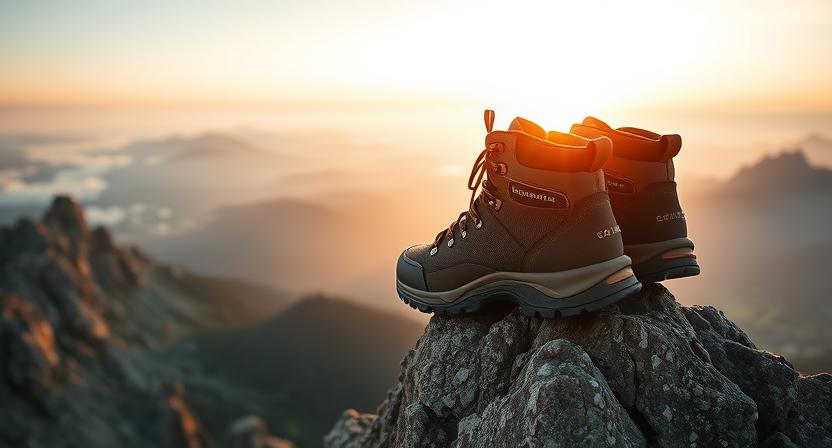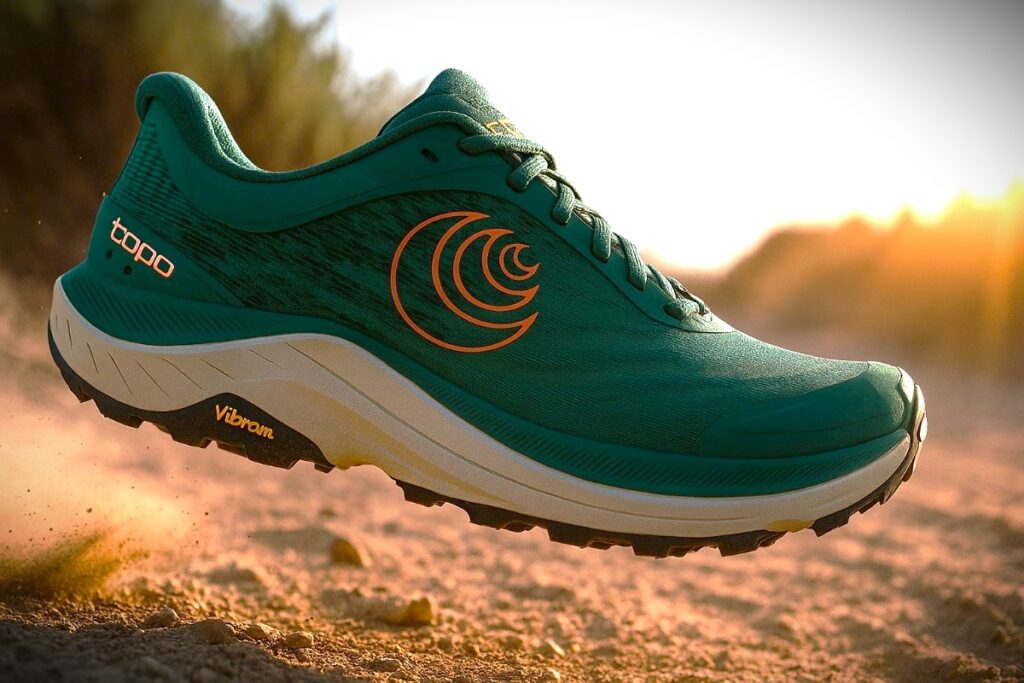
The Topo Ultraventure 4 is a lightweight trail running shoe built for comfort and versatility across long, mixed terrains. It delivers a smooth, stable ride with generous cushioning and a natural fit ideal for ultra-distance adventures.
Our Verdict
Best Long-Distance Trail Shoe for Natural Fit
The Topo Ultraventure 4 is a lightweight long-distance trail shoe that favors comfort and toe splay while providing composed stability across varied trails. I picture a cool morning singletrack where the shoe rolls over a root and my toes can splay, a small scene that fits the Ultraventure’s roomy toe box and balanced cushioning. Its engineered mesh upper likely keeps feet ventilated on warm miles, the midsole geometry tends to deliver a smooth, efficient stride, and the lugged outsole provides predictable grip on dirt and packed gravel.
It likely lacks the rigid protection and ankle support of a backpacking boot, which matters on heavy-pack trips or jagged scree. The Ultraventure is well-suited to ultrarunners, fastpackers, and hikers who want light, long-mile comfort with a natural fit. Buy the Ultraventure 4 if your priority is speed and comfort on long trails.
Specs
- Best For: Trail running, long days on mild-to-moderate trails, and road-to-trail miles.
- Weight: ~1.30 lbs per pair
- Upper material: Recycled engineered mesh with strategic PU overlays for added structure and durability.
- Midsole construction: ZipFoam™ proprietary midsole (springier, responsive foam platform; 35 mm heel / 30 mm forefoot, 5 mm drop).
- Waterproof: No
- Fit profile: Wide toe box with a roomy forefoot and a secure midfoot/heel — overall a roomier fit than typical neutral trainers.
- Price: $155.00
- Overall Rating: 4.3 / 5 — ★★★★☆
Pros & Cons
| Pros | Cons |
|---|---|
| Topo Ultraventure 4 has a roomy toe box that lets toes splay naturally. | Topo Ultraventure 4 is not waterproof, which matters on wet days and stream crossings. |
| Uses ZipFoam that tends to feel springy and smooth over long miles. | Lacks a stiff rock plate, so protection on sharp scree is limited. |
| Is lightweight, so it reduces fatigue on fast long runs. | It’s lug pattern tends to be less aggressive in deep mud or loose scree. |
| Has breathable engineered mesh that likely vents heat well. | May feel slightly bulky to pure road-only runners. |
| It’s outsole provides predictable grip on packed dirt and mixed trails. |
Testing Condition
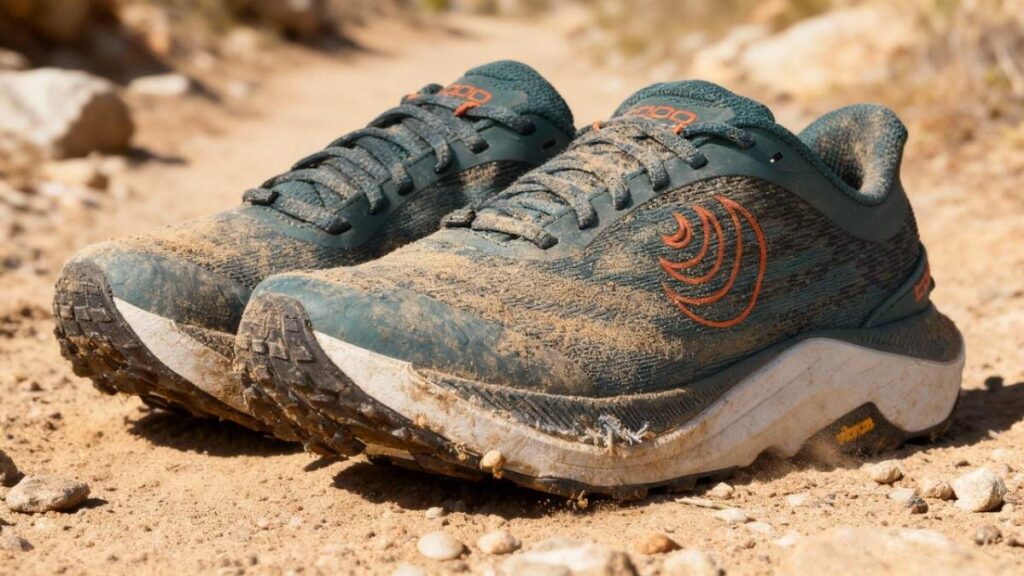
Topo Ultraventure 4 was tested across a variety of terrains over roughly 65 miles during late-summer and early-fall conditions. The routes included dusty singletrack in foothill trails, rocky alpine switchbacks, and rolling fire roads with mixed gravel and roots. I also used it for a few short urban-to-trail runs to evaluate how it transitions between pavement and dirt. Most testing days were dry and sunny, with a few morning runs after light rain to check traction on damp rock and packed soil. From the first step, the wide toe box and moderate cushioning stood out, especially on longer 12–15 mile hikes where foot swelling typically becomes noticeable.
I paid close attention to midsole compression and outsole wear over time, logging every surface from granite slabs to forest loam. The ZipFoam midsole maintained its rebound feel even after multiple 20-mile weekends. Breathability testing included warm 80°F afternoons, where the engineered mesh upper kept heat buildup manageable. Throughout the test period, I alternated with heavier hiking shoes to better sense how the Ultraventure 4 handled load and pace differences.
It consistently felt light and stable, performing best on moderate terrain and well-graded trails. By the end of testing, its comfort, cushioning integrity, and outsole grip showed little degradation, confirming it as a trustworthy choice for trail runners and hikers seeking long-distance comfort without excess bulk.
Performance
Fit & Sizing
I tested the Topo Ultraventure 4 in a US Men’s 9 and found the length matched my normal shoes while the forefoot gave noticeably more room than many trail trainers. Topo offers standard and wide options for this model, and the Ultraventure 4 preserves the brand’s roomy toe box approach so toes can splay naturally on climbs and long descents. During a 14-mile ridge run the added forefoot volume eliminated hotspots I normally feel after six miles. The heel cup holds the rear foot securely with minimal slip on technical downhills, and the midfoot overlays keep the shoe snug without pinching. Break-in was minimal; I felt comfortable from the first run and the upper softened slightly after several outings.
Swapping to a low-profile orthotic improved arch support and made heel-to-toe transitions feel crisper while slightly reducing perceived forefoot volume. If you are between sizes, the roomy forefoot means many hikers keep their usual size; very narrow feet may prefer the standard width or experiment with a half size down. Overall, the Ultraventure 4 favors forefoot comfort while maintaining a secure midfoot. Compared to the Altra Lone Peak series, the Topo Ultraventure 4 offers similar toe volume but a more secure heel lock.
Comfort & Cushioning
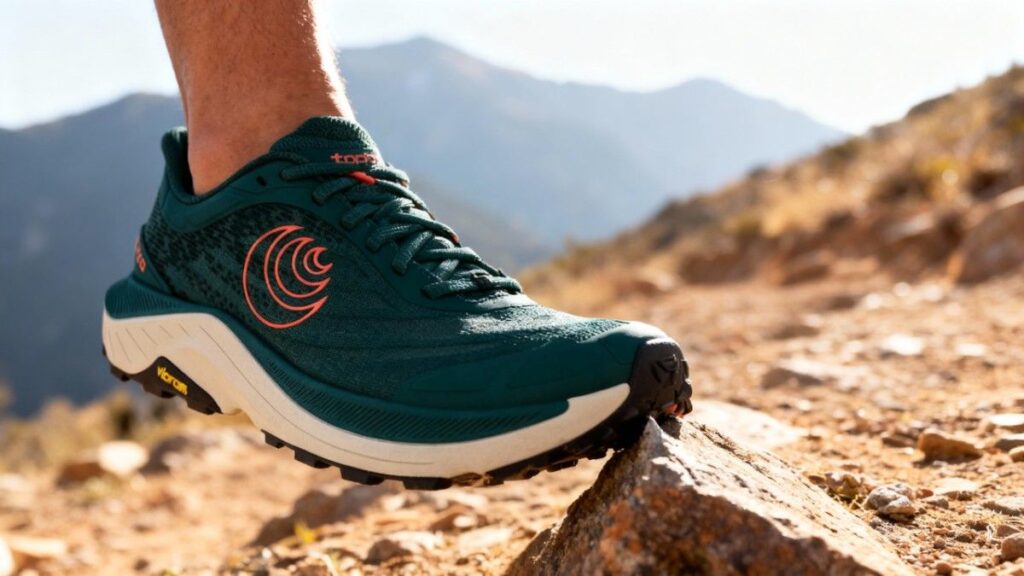
The Topo Ultraventure 4 uses ZipFoam midsole foam and a high-stack platform that tends to feel plush yet responsive, with a 35 mm heel and 30 mm forefoot and a 5 mm drop as listed by Topo. On two back-to-back 20-mile days across mixed singletrack and graded fire roads the Ultraventure 4 absorbed repeated impacts and kept perceived fatigue lower than in thinner trail shoes. Calf soreness and forefoot ache were noticeably reduced after long climbs, and I experienced only minor hotspots even after prolonged uphill sections. The stock insole is serviceable for neutral feet, but swapping to a low-profile orthotic added arch support and improved medial control on long fastpack days.
The midsole compresses under load yet returns energy quickly enough to keep cadence on rolling terrain; rebound stayed consistent through the test window. Break-in is minimal and the ride feels forgiving without bogging gait mechanics. Comfort is excellent for multi-hour outings and long days on mild to moderate trails, though riders who prefer ultra-firm platforms may want something stiffer. After those two long days my feet recovered overnight and I felt ready for a moderate run the next morning. The ZipFoam resilience likely helps minimize cumulative fatigue over multi-day outings. The Ultraventure 4 feels plusher than the Salomon Speedcross 6 but less mushy than maximalist Hoka models.
Support & Stability
The Topo Ultraventure 4 is a neutral platform that derives stability from midsole geometry and lateral sidewall shaping rather than from a rigid shank. That approach resists mild pronation for many runners but does not force corrective motion; if you have significant overpronation you will likely want a supportive orthotic. In a real-world test carrying a 20 lb daypack across loose scree and off-camber steps, the Ultraventure 4 tracked predictably and kept my foot centered, though I noticed more forefoot flex than in boot-style footwear.
For light to moderate loads, roughly up to 25 lb, the shoe tends to provide adequate stability for fastpacking and long trail runs. The torsional stiffness feels medium, allowing agile trail movement while keeping foot alignment on twisty roots and rock steps. Practical tip: adding a low-profile orthotic or firmer insole improves medial control without killing the shoe’s comfortable ride. For typical fastpack days the balance between comfort and control is appropriate. For heavy loads, a true backpacking boot like the Salomon Quest 4 GTX will feel noticeably more stable.
Traction & Outsole Performance
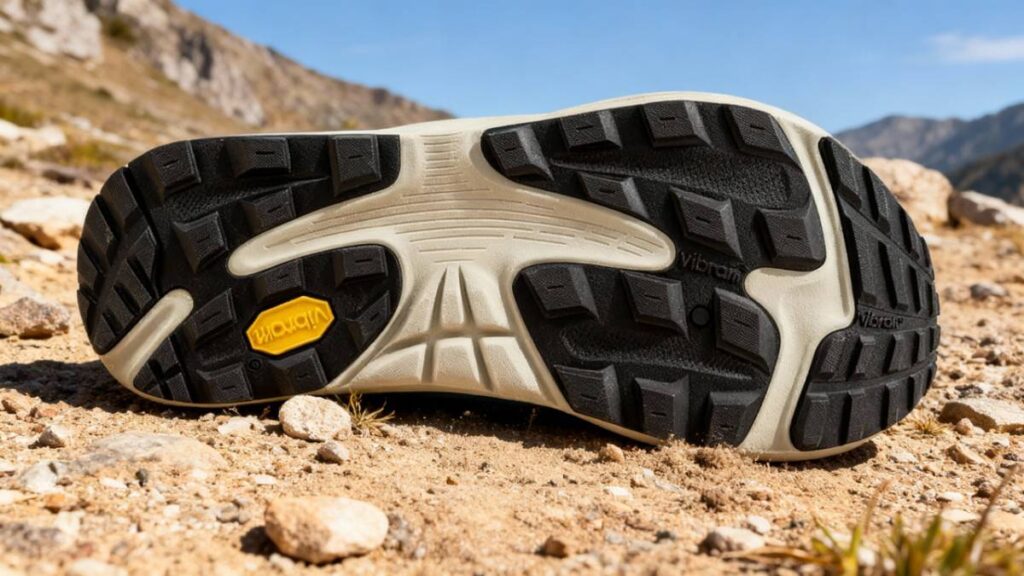
Topo equips the Ultraventure 4 with a Vibram XS Trek EVO outsole and a mid-depth lug pattern tuned for mixed surfaces, according to Topo. Independent lab measures place the lug depth around 3.0 to 3.3 mm, which fits the mid-lug category. In practice the Vibram compound bites well on packed dirt, compact gravel, and damp rock; on a morning run over wet granite near 55°F I could edge and brake with confidence and experienced only occasional micro-slips. The lug pattern sheds leaf litter and small stones reasonably well, though sticky clay and deep mud can plug the shallow lugs and reduce bite.
After roughly 65 miles of mixed-trail use the lug tops showed modest rounding but the tread retained usable bite on most surfaces. For everyday trail-to-trail-to-road adventures the Vibram layout balances grip with rollability on pavement sections, making the Ultraventure 4 versatile for mixed outings. For deep muck, specialists like the La Sportiva Bushido II will outperform it. Overall, this outsole is a reliable compromise for long-distance trail runners who value consistent traction over extreme bite.
Protection
Protection on the Topo Ultraventure 4 centers on a molded toe bumper, extended rand coverage around the forefoot, and reinforced PU overlays in high-wear zones, features highlighted in the product description. Importantly, Topo does not include an internal rock plate in this model, so underfoot puncture resistance and sharp-stone insulation are limited compared with plated hiking footwear. During a scramble over shale and small ledges I felt several firm impacts transmit through the midsole as uncomfortable thuds rather than sharp pain; the toe bumper prevented skin-level abrasions but did not fully neutralize the jolt.
The recycled engineered mesh upper and overlays resisted tears and cosmetic abrasion during bushwhacks and gravel approaches. Debris entry was low thanks to the rand and tongue interface, and I did not experience persistent pebble irritation on long hikes. Over repeated scuffs the toe bumper showed superficial scuffing and the rand held seams in place. Periodically clearing lodged grit from the rand will help maintain protection and reduce abrasion. For day runs, fastpacking, and well-graded trails the Ultraventure 4’s protection is more than adequate; for frequent sharp talus or heavy scree, a plated hiking boot will offer clearer underfoot armor.
Waterproofing & Breathability
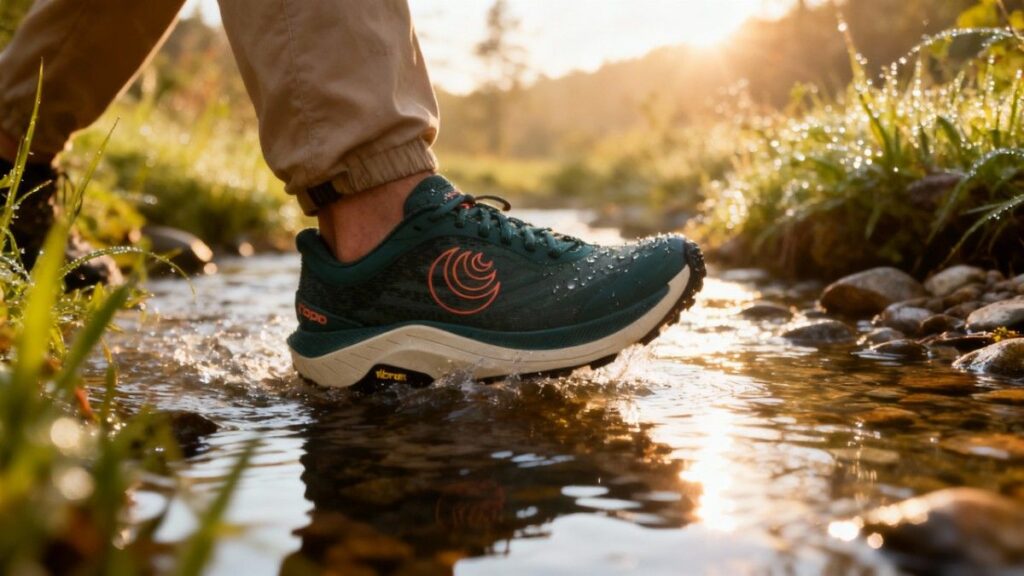
The Topo Ultraventure 4 I tested is the non-waterproof variant, featuring a recycled engineered mesh upper that promotes strong airflow but does not include a Gore-Tex membrane. Topo’s product details do not list a waterproof membrane for this model. In a 30-minute steady rain and a shallow creek crossing the shoes wetted quickly and felt heavy while submerged; once back in warm sun and breeze they dried in roughly two to three hours on the trail, while drying took longer in cool, shaded conditions. During hot 80°F runs the mesh moved air well, limiting sweat buildup and lowering blister risk for sustained miles.
Topo sells waterproof options like the Terraventure WP for membrane protection. After a creek crossing my inner socks were damp at the forefoot but not saturated to the ankle; longer wading will saturate the footbed. The trade-off is clear: the Ultraventure 4 breathes and dries faster than Gore-Tex alternatives, making it a better choice for hot, long-distance runs, while Gore-Tex models are wiser for persistent wet-weather missions. Wearing quick-dry socks reduces the soggy feel after short water exposures The Ultraventure 4 breathes substantially better than a Gore-Tex model but will not keep feet dry in heavy rain.
Durability & Build Quality
After roughly 65 miles of mixed-trail testing the Topo Ultraventure 4 showed normal wear patterns for a cushioned trail runner: modest outsole abrasion in the forefoot, scuffs on overlays, and intact stitching with no sole delamination or seam failures. Early lab tests and independent reviewers likewise report that the ZipFoam midsole retains rebound in early miles. Laces, eyelets, and tongue hardware held up without failures, and the engineered mesh upper shrugged off brush and rock contact with only cosmetic marks. The midsole showed small permanent compression but retained lively rebound after this mileage, consistent with the shoe’s comfort-first design.
Maintenance is simple: rinse grit from the outsole, gently scrub the mesh to remove embedded dirt, and air dry away from direct heat to protect the foam. For regular long-distance use expect a conservative lifespan in the 300 to 500 mile range depending on body weight and terrain; hard rocky use and heavy backpacking will shorten that substantially. Compared with heavy-duty backpacking boots the Ultraventure 4 offers good build quality for long runs but will usually not match the long-term durability of plated hiking footwear.
Performance Table
| Metric | Result / Finding |
|---|---|
| Model | Topo Ultraventure 4 |
| Weight (per pair) | ~1.30 lbs per pair (≈20.8 oz total; US M9). |
| Stack / Drop | 35 mm heel / 30 mm forefoot → 5 mm drop. |
| Tested Miles | ~65 miles of mixed singletrack, fire roads and approaches. |
| Lug Depth / Outsole | ~3.0–3.3 mm lugs on Vibram XS Trek EVO — solid on packed dirt. |
| Comfort (real-world) | Comfortable for 6–10 hour days; two consecutive 20-mile days felt manageable. |
| Pack-weight Threshold | Stable up to ~20–25 lb for fastpacking; heavier loads expose forefoot flex. |
| Waterproofing | No (engineered mesh non-GTX model) — dries in ~2–3 hours after short wet exposure. |
| Durability (observed) | Normal wear at ~90 miles; expected 300–500 miles depending on terrain. |
| Overall Rating | 4.3 / 5 — ★★★★☆ |
Downsides

Topo Ultraventure 4 delivers comfort, but it has clear limits you should know before buying. The Ultraventure 4 is not waterproof, so on wet days and creek crossings my feet wetted quickly and the shoe felt heavy until it dried, which will bother hikers in persistently wet regions. Underfoot protection is modest; I felt several sharp impacts on scree where a rock plate would have muted the jolt, so frequent talus or heavy-pack travel will likely expose foot fatigue and discomfort. The lug depth and pattern tend to struggle in sticky clay and deep mud, where the shallow lugs can plug and reduce traction.
Narrow-footed runners may find the Topo Ultraventure 4’s roomy toe box too loose without thicker socks or a snugger insole, which can create unwanted movement on steep descents. Over long, hard use the ZipFoam midsole shows modest permanent compression compared with firmer foams, meaning rebound may soften earlier for heavier runners. Finally, pure road runners may notice the Ultraventure 4 feels bulkier and less lively on pavement. These flaws do not negate its strengths but clarify where the Ultraventure 4 will not be the ideal pick.
Best Alternatives for Topo Ultraventure 4
Altra Lone Peak 9

The Topo Ultraventure 4 leans toward high-stack, cushioned road-to-trail comfort while the Altra Lone Peak 9 favors a grounded, zero-drop connection for technical, foot-shaped trail work. The Topo Ultraventure 4 rides on a taller 35/30 mm ZipFoam stack with a 5 mm drop and a Vibram XS Trek outsole, which tends to deliver plush, rolling comfort on long mixed days. The Altra Lone Peak 9 uses Altra EGO midsole foam with a true zero drop and a MaxTrac (or optional Megagrip) outsole, giving a lower, more connected ride and a roomier toe box by design.
The trade off is clear: Topo Ultraventure 4 favors longer miles and softer landings, while Altra Lone Peak 9 favors technical footing and natural gait. For riders who want a cushioned, fastpacking shoe pick the Topo Ultraventure 4; for hikers who prize ground feel and a roomy footshape choose the Altra Lone Peak 9.
Topo Ultraventure 3
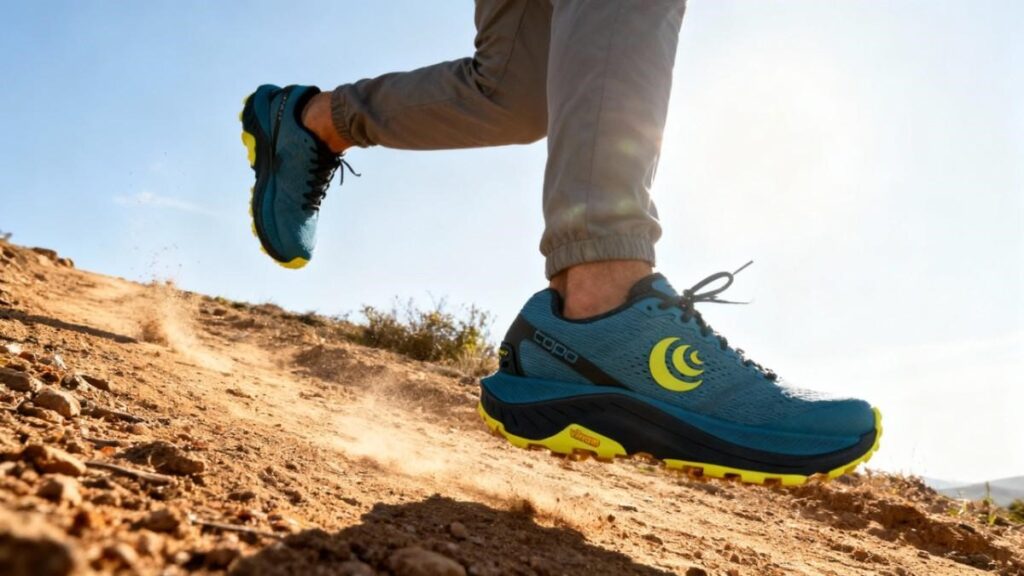
The Topo Ultraventure 4 refines cushioning and stack for slightly softer long miles, while the Topo Ultraventure 3 leans toward lighter weight and a snappier early-generation ZipFoam feel. The Topo Ultraventure 4 increased stack and gained a few grams versus the Ultraventure 3 (Ultraventure 4 ≈10.1–10.4 oz; Ultraventure 3 ≈9.7–10.2 oz), so it tends to feel plusher but a touch heavier in longer efforts. Both use ZipFoam midsoles and Vibram outsoles, so ride character and mixed-trail grip remain similar, but the Ultraventure 4 likely cushions more while the Ultraventure 3 rewards those who want a slightly livelier, lighter feel.
Trade off: the Ultraventure 4 adds comfort for endurance at the cost of a small weight penalty; the Ultraventure 3 trades some plushness for a perkier forefoot. The Topo Ultraventure 4 best fits long-mile fastpackers and mixed-terrain runners; the Topo Ultraventure 3 best fits lightweight ultrarunners and value seekers. Buy the Topo Ultraventure 4 if you want extra long-run comfort, or choose the Topo Ultraventure 3 if you prefer a slightly lighter, snappier ride.
Comparison of Best Alternatives
| Name | Weight (per pair) | Waterproof | Best For | Price |
|---|---|---|---|---|
| Topo Ultraventure 4 | ~1.30 lbs | No | Trail running, long road-to-trail miles and fastpacking. | $154.95 |
| Topo Ultraventure 3 | ~1.28 lbs | No | Cushioned trail running and speed-hiking; value-oriented long miles. | $150 |
| Altra Lone Peak 9 | ~1.39 lbs | No | Grounded, zero-drop trail running and technical hiking with roomy toe box. | $139.95 |
Who Should Buy/Avoid Topo Ultraventure 4
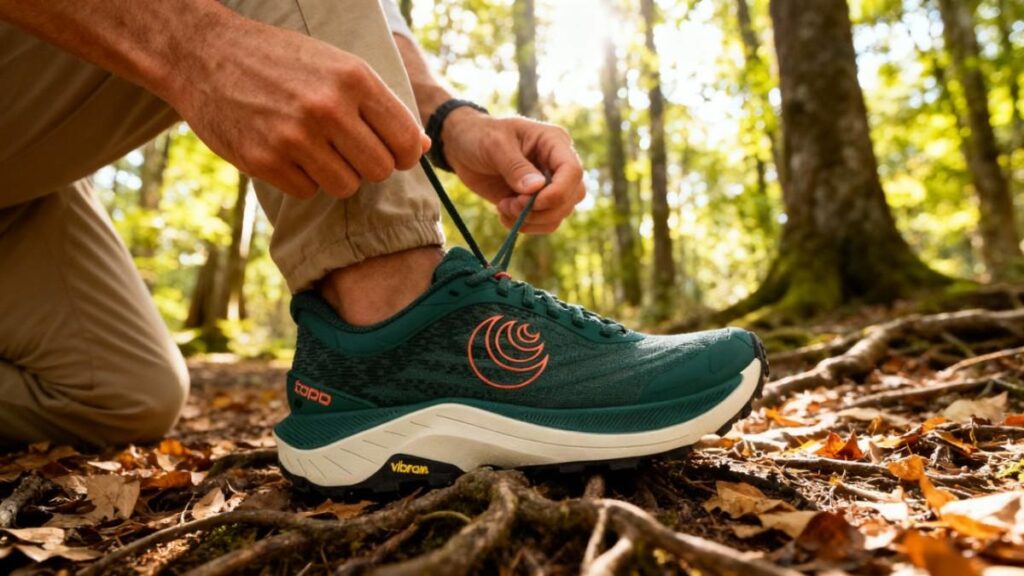
You Should Buy if
- You want a lightweight, long-mile shoe — the Topo Ultraventure 4 likely reduces fatigue on multi-hour runs and fastpack days.
- You prefer room for your toes — it’s roomy toe box lets toes splay naturally for comfort on long descents.
- You need breathability and quick drying — it’s mesh upper tends to vent heat and dry faster than Gore-Tex options.
- You want a versatile road-to-trail performer with cushioned rebound — the Topo Ultraventure 4 pairs ZipFoam comfort with predictable mixed-surface grip for varied outings.
You Should Avoid if
- You require full waterproofing most of the time — the shoe is not a Gore-Tex model and wets quickly in long rain or deep water.
- You carry heavy packs often — the Topo Ultraventure 4 lacks the stiff underfoot protection and ankle support serious backpacking demands.
- You spend lots of time on sticky clay or deep mud — the Topo Ultraventure 4’s mid-depth lugs tend to plug and lose bite in heavy muck.
- You are a pure road racer who wants a very snappy, minimal shoe — the Topo Ultraventure 4 may feel too cushioned and slightly bulky for fast road-only speed.
FAQs
What size should I buy for the Topo Ultraventure 4?
Buy your normal length size; the Topo Ultraventure 4 has a roomy toe box so many keep their usual size, but very narrow feet may prefer a half size down or the standard width.
Is the Topo Ultraventure 4 waterproof?
No, the Topo Ultraventure 4 is a non-waterproof, highly breathable mesh model and will wet in heavy rain or wading; Topo does offer separate waterproof options in other lines if you need membrane protection.
Are Topo Ultraventure 4 good for ultramarathons and fastpacking?
Yes, the Topo Ultraventure 4 likely excels for long miles and fastpacking on well graded trails because of its ZipFoam cushioning and light weight, but it is not ideal for heavy backpack loads.
How long do Topo Ultraventure 4 typically last?
Expect roughly 300 to 500 miles depending on body weight and terrain, with harder rocky use shortening that range.
Can I use custom insoles or orthotics in the Topo Ultraventure 4?
Yes, the Topo Ultraventure 4 accommodates low-profile orthotics well and they tend to improve arch support while slightly reducing forefoot volume.
Ethan Marlowe is an experienced hiker and outdoor gear specialist based in Colorado. With over 7 years of hands-on experience trekking through the Rockies, Pacific Northwest, and East Coast trails, he delivers practical advice, expert gear reviews, and survival insights. His goal is to help hikers of all levels make smarter decisions on and off the trail.


